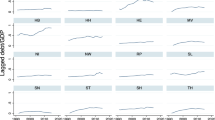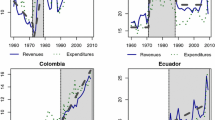Abstract
The academic literature has focused largely on testing for long-run fiscal sustainability. In this exercise we formulate a flexible regression model that can be used to assess the sustainability of a more recent build-up of fiscal deficits and debt that would be of major concern to policy makers. The analysis of US data shows that, after adjusting for some fundamentals, the gross Federal debt–income ratio has been growing at an unsustainable rate of 4 % per year since 2007. The net debt–income ratio does not show such a significant trend. Since not all government assets are readily available to reduce debt, significant positive trends in the gross debt–income ratio calls for policy actions.
Similar content being viewed by others
References
Abel AB, Mankiw N, Summers LH, Zeckhauser RJ (1989) Assessing dynamic efficiency: theory and evidence. Rev Econ Stud 56: 1–19
Ahmed S, Rogers JH (1995) Government budget deficits and trade deficits: are present value constraints satisfied in long-term data. J Monet Econ 36: 351–374
Auerbach AJ (1997) Quantifying the current U.S. fiscal imbalance. Natl Tax J 50: 387–398
Auerbach AJ, Gale WG, Orszag PR, Potter SR (2003) Budget blues: the fiscal outlook and options for reforms. In: Aaron H, Lindsay J, Nivola P (eds) Agenda for the Nation. Brookings Institute, Washington, pp 109–143
Bajo-Rubio O, Diaz-Roldan C, Esteve V (2004) Searching for threshold effects in the evolution of budget deficits: an application to the Spanish case. Econ Lett 82: 239–243
Bernanke BS (2010) Achieving fiscal sustainability. In: Speech given at the National Commission on fiscal responsibility and reform, Washington DC, April 27
Bohn H (1998) The behaviour of U.S. public debt and deficits. Q J Econ 113: 943–963
Bohn H (2005) The sustainability of fiscal policy in the United States. http://www.econ.ucsb.edu/~bohn/papers/DebtUS.pdf (see also In: Neck R, Sturm J (2008) Sustainability of Public Debt. MIT Press, Cambridge, pp 15–49). Accessed March 2011
Bohn H (2007) Are stationarity and cointegration restrictions really necessary for the intertemporal budget constraint. J Monet Econ 54: 1848–1862
Buiter WH, Patel UR (1992) Debt, deficits and inflation: an application to the public finances of India. J Public Econ 47: 171–205
Campbell JY, Shiller RJ (1987) Cointegration and tests of present value models. J Political Econ 95: 1062–1088
Cipollini A (2001) Testing the government inter-temporal solvency: a smooth transition error correction model approach. Manch Sch 69: 643–655
Chortareas G, Kapetanios G, Uctum M (2008) Nonlinear alternatives to unit root tests and public finance sustainability: some evidence from Latin American and Caribbean countries. Oxf Bull Econ Stat 70: 645–663
Corsetti G, Roubini N, (1991) Fiscal deficits, public debts and government solvency: evidence from OECD countries. NBER working paper, 3658. National Bureau of Economic Research, Cambridge
Davig T (2005) Periodically expanding discounted debt: a threat to fiscal policy sustainability. J Appl Econ 20: 829–840
Draper NR, Smith H (1966) Applied regression analysis. Wiley, New York
Engle C, West KD (2004) Accounting for exchange rate variability in present value models when the discount factor is nearly 1. Am Econ Rev 94: 119–125
Gabriel VJ, Sangduan P (2011) Assessing fiscal sustainability subjected to policy changes: a Markov switching cointegration approach. Empir Econ 41: 371–385
Gerson P, Nellor D (1997) Philippine fiscal policy: sustainability, growth and savings. In: Hicklin J, Robinson D, Singh A (eds) Macroeconomic issues facing ASEAN countries. IMF, Washington, pp 91–129
Giannitsarou C, Scott A (2006) Inflation implications of rising government debt. NBER working paper, 12654. National Bureau of Economic Research, Cambridge
Greiner A, Köller U, Semmler W (2007) Debt sustainability in the European Monetary Union: theory and empirical evidence for selected countries. Oxf Econ Pap 59: 194–218
Hakkio CR, Rush M (1991) Is the budget deficit too large. Econ Inq 29: 29–45
Hamilton JD, Flavin MA (1986) On the limitations of government borrowing: a framework for empirical testing. Am Econ Rev 76: 808–819
Hansen LP, Sargent TJ (1980) Formulating and estimating rational expectations models. J Econ Dyn Control 2: 7–46
Hansen LP, Roberts W, Sargent TJ (1991) Time series implications of present value budget balance and of martingale models of consumption and taxes. In: Hansen LP, Sargent TJ (eds) Rational expectations econometrics. Westview Press, Boulder, pp 121–161
Haug AA (1991) Cointegration and government budget constraints: Evidence for the United States. J Bus Econ Stat 9: 97–101
Haug AA (1995) Has federal budget deficit policy changed in recent years. Econ Inq 33: 104–118
Hoover K (2001) Causality in macroeconomics. Cambridge University Press, Cambridge
Jha R, Sharma A (2004) Structural breaks, unit roots and cointegration: a further test of the sustainability of the Indian fiscal deficit. Public Finance Rev 32: 196–219
Kim HJ, Fay MP, Feuer EJ, Midthune D (2000) Permutation tests for joinpoint regression with applications to cancer rates. Stat Med 19: 335–351
Kremers JJM (1989) U.S. federal indebtness and the conduct of fiscal policy. J Monet Econ 23: 219–238
Lima LR, Gaglianone WP, Sampaio RMB (2008) Debt ceiling and fiscal sustainability in Brazil: a qantile autoregression approach. J Dev Econ 86: 313–335
Martin GM (2000) US deficit sustainability: A new approach based on multiple endogenous breaks. J Appl Econom 15: 83–105
McCallum BT (1984) Are bond-financed deficits inflationary? A Ricardian analysis. J Political Econ 92: 123–135
Quintos CE (1995) Sustainability of the deficit process with structural shifts. J Bus Econ Stat 13: 409–417
Rich RW, Rissmiller D (2000) Understanding recent behavior of US inflation rate, FRBNY. Curr Issues Econ Finance 6: 1–6
Sargent TJ (1978) Rational expectations, econometric exogeneity, and consumption. J Political Econ 86: 673–700
Stella P (2009) The Federal Reserve system balance sheet: what happened and why it matters. IMF working papers, WP/09/120, Washington
Tanner E, Liu P (1994) Is budget deficits too large? Some further evidence. Econ Inq 32: 511–518
Trehan B, Walsh CE (1988) Common trends, the government’s budget constraint and revenue smoothing. J Econ Dyn Control 12: 425–444
Trehan B, Walsh CE (1991) Testing intertemporal budget constraints: theory and applications to US federal budget and current account deficits. J Money Credit Bank 23: 206–223
Uctum M, Wickens M (2000) Debt and deficit ceilings, and sustainability of fiscal policies: an intertemporal analysis. Oxf Bull Econ Stat 62: 197–222
Velasco A (2000) Debt and deficits with fragmented fiscal policymaking. J Public Econ 76: 105–125
Wallis KF (1980) Econometric implications of rational expectations hypothesis. Econometrica 48: 49–74
Wilcox DW (1989) The sustainability of government deficits: implications of the present value borrowing constraint. J Money Credit Bank 21: 291–306
Author information
Authors and Affiliations
Corresponding author
Rights and permissions
About this article
Cite this article
Abeysinghe, T., Jayawickrama, A. A segmented trend model to assess fiscal sustainability: The US experience 1929–2009. Empir Econ 44, 1129–1141 (2013). https://doi.org/10.1007/s00181-012-0584-2
Received:
Accepted:
Published:
Issue Date:
DOI: https://doi.org/10.1007/s00181-012-0584-2
Keywords
- Present-value borrowing constraint
- Long-run and short-run fiscal sustainability
- Rational expectations
- Unadjusted and adjusted trends of debt ratios




